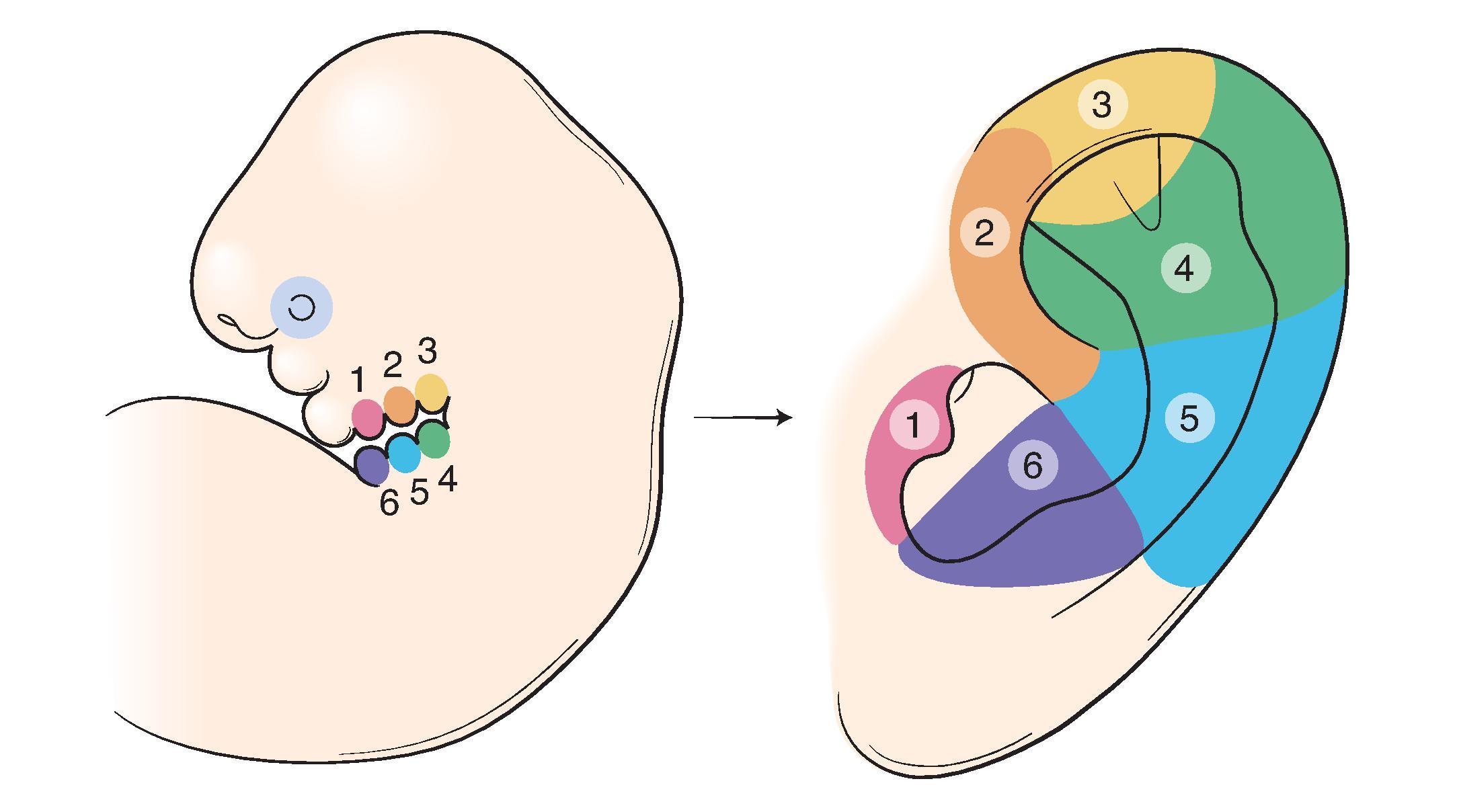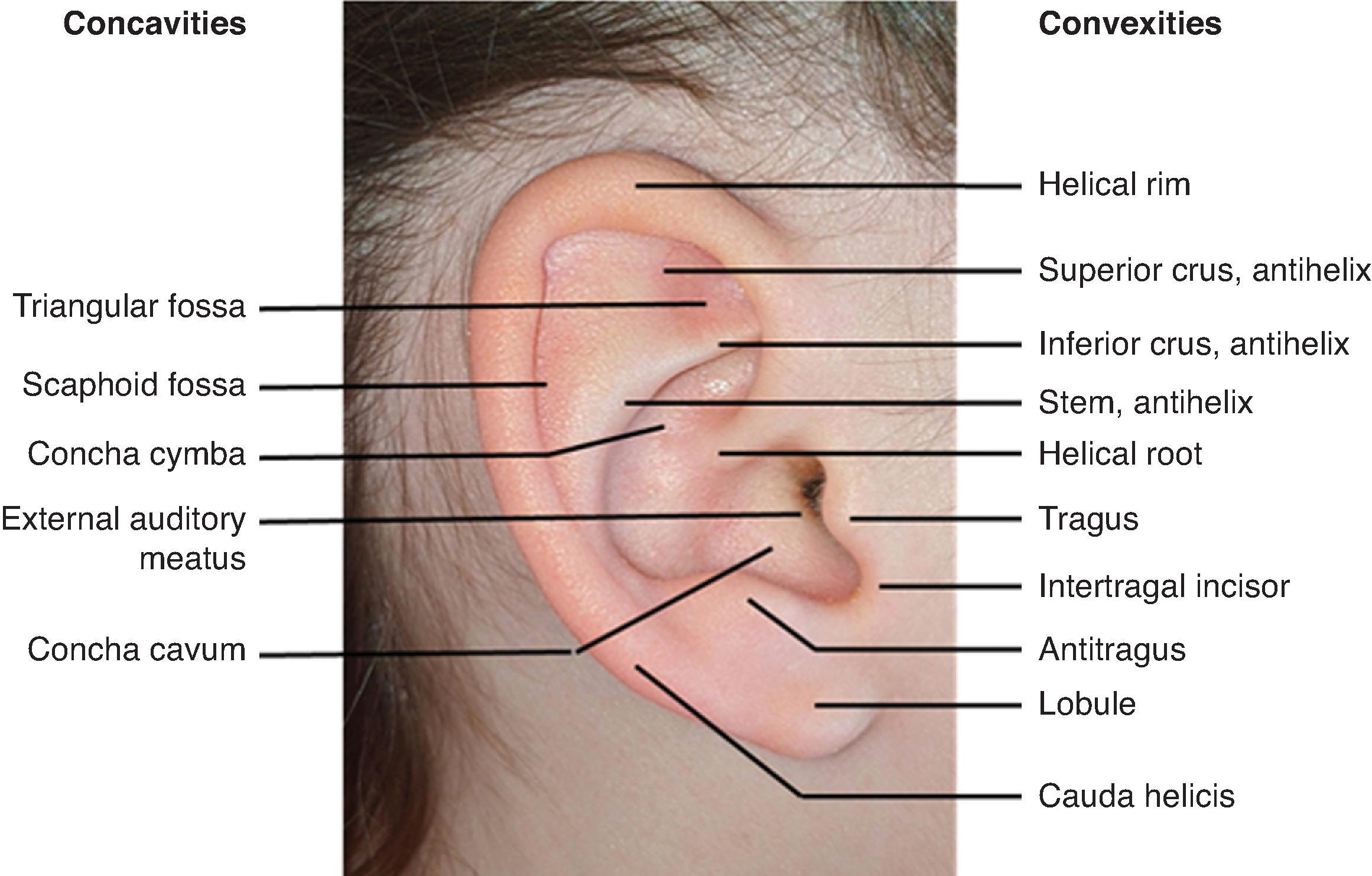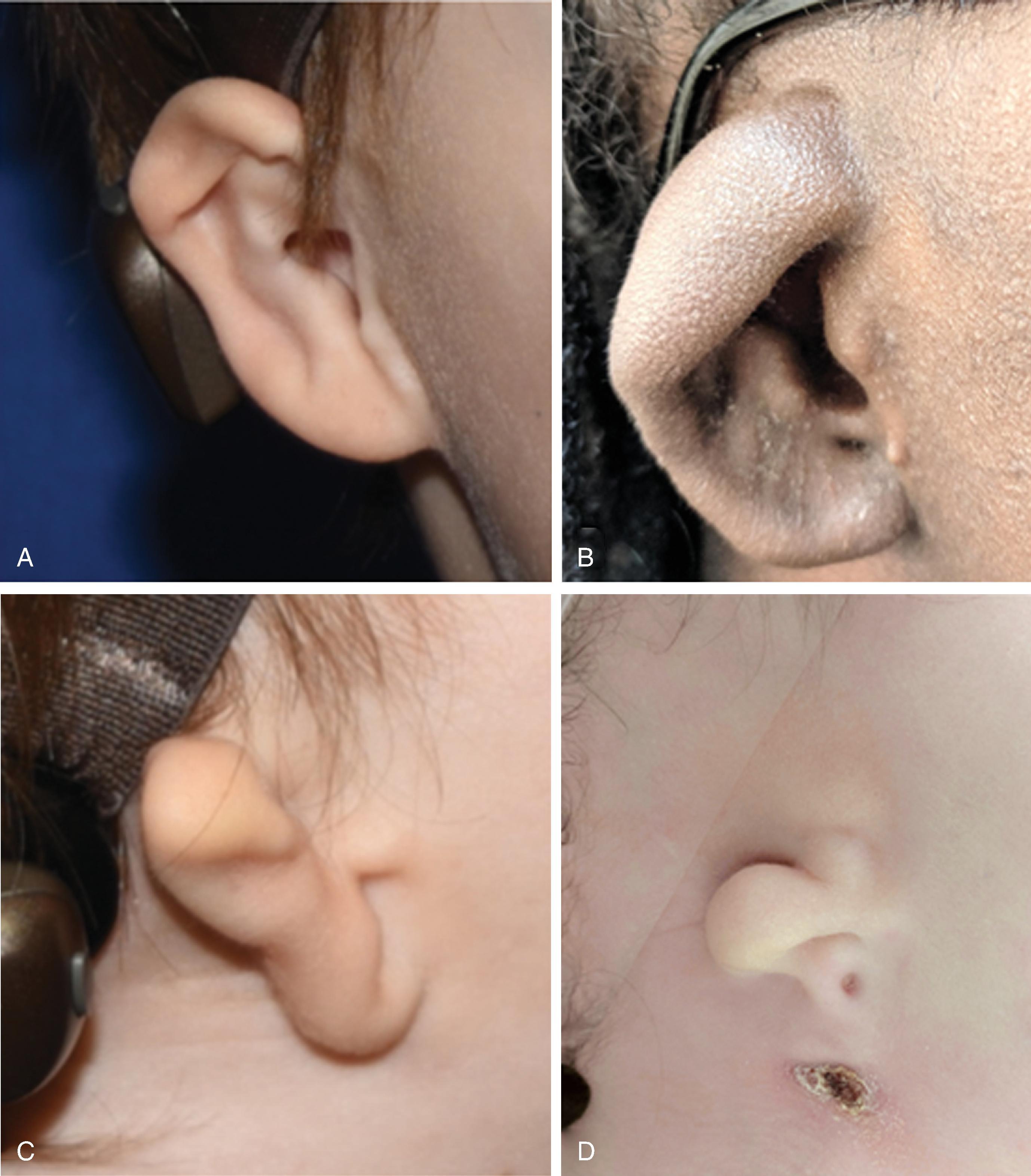Physical Address
304 North Cardinal St.
Dorchester Center, MA 02124
The treatment and care of patients with auricular malformations requires a detailed and comprehensive approach for optimal outcomes. It is ideal to establish a relationship with patients and their families early in diagnosis to provide accurate information and address unanswered questions. When ear reconstruction is undertaken by inexperienced teams, outcomes can be variable, sometimes devastating, and may limit opportunities for revision or other therapeutic options.
In this chapter, we aim to provide a thorough understanding of the assessment, planning, treatment, and postoperative management of microtia. Focused training, as well as mentored experience, is critical. Similar to the management approach taken with complex orofacial cleft care, multiple medical disciplines are involved in the management of microtia. These include audiology, primary care, reconstructive surgery, speech and language pathology, anaplastology, and human genetics. The combined efforts of these disciplines can ensure a cohesive treatment approach for children and their families. Clearly delineating the goals of care, such as rehabilitating or restoring hearing through the use of headband-held and osseointegrated bone conduction devices or atresiaplasty and reconstructing the auricle so it is as near to normal appearing as possible, is paramount. Ancillary testing often includes the assurance of a normal renal ultrasound and consideration of genetic and cardiac testing, particularly in patients with global syndromic concern.
Considering the unique concavities and convexities that constitute the normal ear anatomy, it is miraculous that normal development predominates. Early development of the auricle is first observed in the 5-week-old embryo. The auricle begins as six mesenchymal proliferations at the dorsal end of the first and second pharyngeal arches surrounding the first pharyngeal cleft. As the mandible develops, the ear ascends to the side of the head at the level of the eyes. The commonly accepted embryologic theory ( Fig. 23.1 ) is that the six hillocks correlate directly with the formation of the tragus, helix, cymba, scapha, antihelix, and antitragus.

The auricle receives its blood supply from the superficial temporal, posterior auricular, and occipital arteries. The venous drainage of the auricle is by the posterior auricular, external jugular, superficial temporal, and retromandibular veins. The lymphatics of the ear drain anteriorly to the parotid lymph nodes and posteriorly to the cervical lymph nodes. The auricular muscles are innervated by branches of the facial (VII) nerve. The temporal branch of the facial nerve supplies the anterior and superior auricular muscles, and a posterior auricular branch of the same nerve supplies the posterior auricular muscle. Sensory innervation of the auricle is from the lesser occipital, great auricular (C2, C3), and auriculotemporal nerves. Arnold’s nerve, a branch of the vagus (X) nerve, supplies the concha.
An appropriately developed auricle is shown in Fig. 23.2 . The vertical axis of the normal auricle is approximately 10° vertical to the plane of the nasal dorsum. The vertical height of the normal ear is approximately equal to the distance between the lateral bony orbital rim and the root of the helix (∼6 cm). The width of the ear is approximately 55% of its height. Typically, the helical rim protrudes 1 cm to 2 cm from the skull, and the angle of protrusion is typically between 20° and 25°. On a horizontal axis, the superior aspect of the ear is usually level with the eyebrow and the lobule with the nasal alar base.

Microtia, or a small or malformed ear, occurs with an incidence of 1 to 10 cases per 10,000 births. Although associated with many syndromes, such as craniofacial and hemifacial microsomia, it occurs in isolation and unilaterally in approximately 90% of cases. Even in apparent isolation, frequent slight asymmetry of the angle of the mandible and palate can be appreciated. The right side is more commonly affected, and microtia is more common in males than females. Ethnic groups with the highest incidence include Andeans, Native Americans, Asians, and Hispanics.
Approximately 75% of cases of microtia have concurrent auditory canal atresia. The exact cause of microtia is unknown, but it is likely multifactorial. Etiologic factors have included neural crest cell disturbance, vascular disruption during fetal development, and living at higher altitudes. Many genes have been associated with microtia. Teratogens have been implicated in mouse models exposed to retinoic acid, leading to disruptions of the second branchial arch that result in severe external and middle ear malformations. Rubella, other viral infections, alcohol abuse, thalidomide, and other etiologies have also been suggested as possible contributors. Existing data indicate that Mendelian genetics is more likely in syndromic or familial cases of microtia, whereas multifactorial causes are more probable in sporadic cases. When associated with other anomalies such as renal, cardiac, and spinal anomalies, microtia is often part of an oculo-auricular-vertebral spectrum (OAVS). Microtia is also a common feature of craniofacial microsomia, mandibulofacial dysostoses (e.g., Treacher Collins), and a lengthy list of other syndromes.
Aguilar and Jahrsdoerfer described a concise classification of congenital ear malformations: Grade I is a near normal ear; Grade II has some of the auricular framework present, but there are obvious deformities; and Grade III is the more common “peanut ear” deformity.
Over the years, many other classification systems have been proposed. The authors use a combined classification consisting of Grades I to IV ( Fig. 23.3 ) and Nagata’s descriptive classification to describe the ear remnants: lobular type, small conchal type, conchal type, and atypical. This classification provides a general grouping and describes the clinical appearance of the ear malformation, which has relevance in preoperative planning of skin incision placement and the amount of donor costal cartilage required for reconstruction.

Treatment options for management of microtia include observation, use of a prosthesis, and surgical reconstruction with autogenous cartilage or an alloplastic implant. In-depth, informed, shared decision making is paramount in selecting which treatment option best fits an individual patient. Most patients opt to pursue some form of reconstruction; studies have shown high rates of depression and anxiety in patients with microtia and less psychosocial stressors after undergoing microtia reconstruction.
Relying on an auricular prosthesis rather than reconstructive surgery has the advantage of a simple, predictable cosmetic option with potentially no surgical risk or donor site morbidity. Methods of prosthesis attachment include adhesives or titanium osseointegrated systems, with the latter requiring surgery. Computer science with virtual planning and three-dimensional (3D) printing of a mirrored replica of the contralateral ear may enhance the quality of the prosthetic. Much like the surgical outcome is dependent on the experience of the surgeon, the key to the success of this approach is in the art of making the prosthesis by a dedicated anaplastologist. Even so, the financial cost, need for replacement every 6 months to 2 years, and maintenance of the prosthesis are disadvantages. The daily removal of the prosthesis and required hygiene routine serve as a constant reminder of the deformity. Patients do not identify a prosthesis as part of themselves compared with a reconstructed ear. No prosthesis can replicate the texture, temperature, and quality of normal skin. If a patient’s skin tone varies by season, multiple prosthetics with different skin tones may be necessary. Because of the overriding disadvantages of financial cost, required daily maintenance, and patient psychology, indications for auricular reconstruction may be favored. Nevertheless, in cases of cancer resection, previous radiotherapy, deficient soft tissue coverage, previously failed autogenous or alloplastic implants, severe craniofacial anomaly, or patient preference, use of a prosthetic ear may be preferred to reconstruction.
Surgical reconstruction using an autologous rib as an auricular framework has been the gold standard of treatment with use of an alloplastic implant being preferred by some surgeons. To decrease complications of alloplastic implants, Reinisch has evolved his technique over three decades in more than 1500 patients using Medpor (Stryker, USA), a synthetic and biocompatible porous polyethylene (PPE) implant. Medpor exposure is unforgiving because the overlying soft tissue will not heal spontaneously. In the most experienced surgeon’s hands, the complication rates of implant fractures (28%) and implant exposure (44%) in 25 cases reported between 1993 and 1995 were reduced to a 1.5% to 8.7% implant fracture and 4.3% implant exposure rate in 487 cases reported between 2008 and 2013. The dramatic decrease in exposure rates can be attributed to coverage of the entire implant with a vascularized temporoparietal fascia flap. Of interest, in 59 salvage or revision cases performed by Reinisch, 14 patients were failed autogenous rib cartilage surgeries, whereas 45 patients were failed Medpor reconstructions.
Benefits of using an alloplastic auricular framework include earlier potential for surgery (as early as 3 years of age given no dependency on chest wall size); avoidance of chest wall donor site discomfort and morbidity; a single outpatient procedure; and, in experienced hands, reliable ear definition and projection. All of these advantages decrease the physical and psychological effects on the child and parents. Furthermore, the learning curve for surgeons may be shorter using an alloplastic auricular framework compared with using autologous cartilage as a framework. Atresia repair may also occur concomitantly with ear reconstruction using an alloplast.
Despite advancements in other techniques, using an autologous rib graft framework remains the gold standard for microtia reconstruction. The long-term durability in response to trauma, and low subsequent implant exposure, or infection and an acceptable aesthetic result have contributed to the success of this method. Tanzer is credited with first using autologous rib grafts for auricular reconstruction in 1959. Burt Brent, Satoru Nagata, and Francois Firmin all contributed major modifications in surgical technique, timing of surgery, and patient selection.
Become a Clinical Tree membership for Full access and enjoy Unlimited articles
If you are a member. Log in here